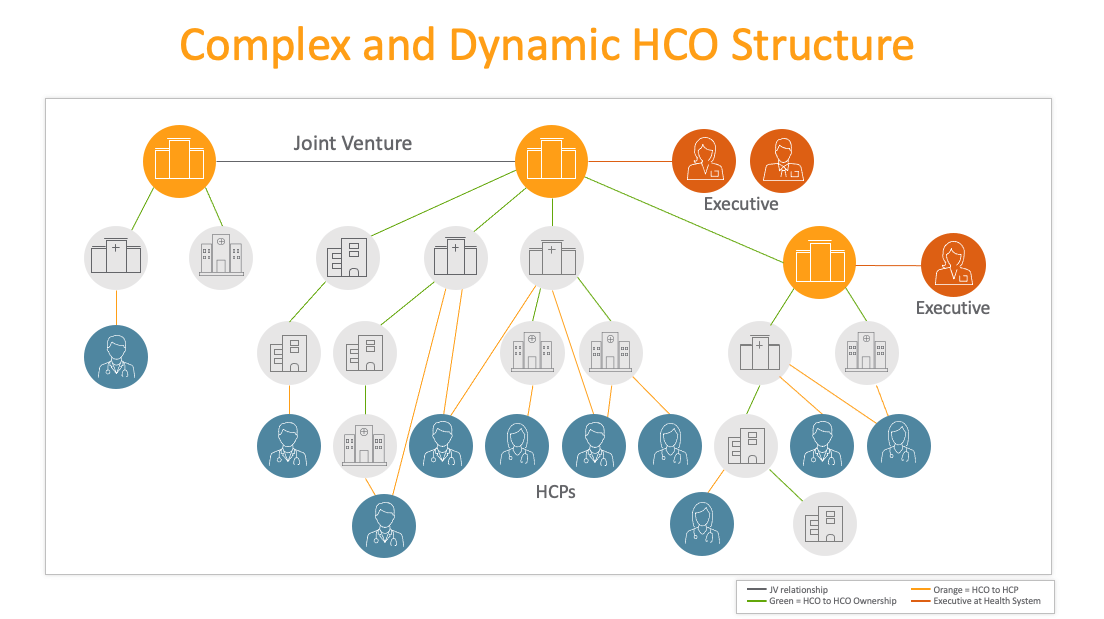Improving Field Execution with Hierarchies and Affiliations Data
Back when I first started working in the pharmaceutical data space in the early 2000s, field teams were mainly focused on three types of data: sales, prescription, and weekly data. But today, they need that and a whole new subset of hierarchies and affiliations data to navigate the complex health systems that only continue to grow bigger and bigger every day.
Of course, simply throwing more data into the mix is not going to make targeting with precision any easier. When a rep has too much information at their disposal, the data becomes unactionable. With more data points — and more data consumers within an organization — it’s all about finding the right balance between simplicity and complexity of customer reference data.
Different stakeholders need different views
Healthcare systems are constantly restructuring and consolidating. We see healthcare organizations (HCOs) affiliated with other HCOs, while some are directly affiliated with an integrated delivery network (IDN). Healthcare professionals (HCPs) have multiple affiliations to groups and hospitals. Even the IDN parent itself has a subsidiary system, with its own set of affiliations or joint venture partnerships with entirely separate systems.

While this level of granularity is important to understand, not all stakeholders in an organization want all the details and may instead only care about the aggregated data at the top of an IDN system. Key account management (KAM) and traditional reps have different preferences, as do home office users who may only want to see a roll-up of HCO activities.
That’s why Veeva OpenData and Veeva Network provide the option to flatten hierarchies by identifying all HCOs and HCPs that fall under an HCO, regardless of the number of hierarchy layers. This bundling also gives customers the flexibility to create new hierarchies based on a user’s business need — for example, giving field teams simplified and relevant roll-ups that outline the strength of relationships for primary affiliations. In this case, instead of leaving them with a large, complex map of an organization that’s as clear as mud, they know exactly who to talk to.
Understanding the science of influence
When Bayer was looking for a vendor to provide hierarchies and affiliations data, the enterprise data management team had two key criteria in mind. First was the fluidity of the data, meaning how well the data was able to keep up with an evolving market where physicians’ affiliations are constantly changing. Secondly, it wanted a vendor that had a good understanding of the building blocks that make up hierarchies and affiliations data.
“Understanding the science of influence only works when you understand how the relationships between the entities work,” says Tarun Kumar, Bayer’s former U.S. head of enterprise data management.
With OpenData’s hierarchies and affiliations data, Bayer has access to custom, simplified hierarchies that filter out irrelevant HCOs, departments, or clinics for its field team. This is done through a custom relationship score that gets attached to every relationship across a healthcare system, based on individual use cases. A better understanding of HCP-HCO relationships means that Bayer’s reps know to talk to the C-suite when decision making is happening centrally or work at a grassroots level if decisions are being made locally.
Depth and breadth of hierarchies
At Shionogi, hierarchies and affiliations data has helped grow the team’s commercial analytics in several ways. Field teams know exactly what’s going on from the IDN down to the HCP, while the back office now has visibility into different levels of the hospital.
“The depth and breadth of hierarchies that we’ve seen within Veeva OpenData allow us to go from the top-level IDN down through all of the steps — the local hospitals, the departments in the hospitals, pharmacies in the hospitals, right on down to the HCPs,” says Scott Eaves, associate director of sales force technology at Shionogi. “It allows us to have that full view of what’s going on for both calls and reporting.”
Access to comprehensive and accurate customer reference data is key to improving sales execution and planning. And with options for how you view your hierarchies and affiliations data, our goal with OpenData is to make that even easier.
Learn more about the importance of having strong hierarchies and affiliations data in this video about Bayer’s customer data strategy.